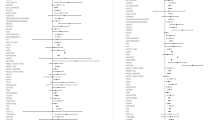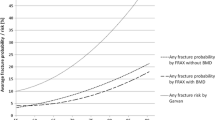Abstract
Summary
The short-term association between wrist-fracture history and future fracture has not been simultaneously compared between younger and older postmenopausal women. This 3-year follow-up study of 158,940 women showed a similar future fracture risk in younger and older women with wrist-fracture history.
Introduction
We examined the association between prior wrist fracture and future osteoporosis-related fractures within 3 years in younger and older postmenopausal women.
Methods
In the National Osteoporosis Risk Assessment (NORA) study, 158,940 postmenopausal women, aged 50-98 (median 63) years, provided information on fracture history since age 45, and responded to follow-up surveys 1 or 3 years later when new fractures were queried. Cox regression models were used to obtain relative risk (RR) and 95% confidence interval (CI) estimates.
Results
Of the 158,940 participants, 8,665 reported a history of wrist fracture at baseline; 4,316 women reported at least one new fracture within three years. The RR for any subsequent clinical fracture, adjusted for covariates and baseline BMD T-score, was 2.4 (2.0, 2.9) for younger and 2.1 (1.9, 2.3) for older women. A prior wrist fracture increased the risk of a future wrist fracture about 3-fold and doubled the risk of any osteoporotic fracture.
Conclusions
Prior wrist fracture strongly predicts three-year risk of any future osteoporotic fracture for older and younger postmenopausal women, independent of baseline BMD and common osteoporosis risk factors. More consideration should be given to evaluating and managing osteoporosis in younger and older women with a history of wrist fracture, independent of their BMD.

Similar content being viewed by others
References
Klotzbuecher CM RP, Landsman PB, Abbott TA III, Berger M (2000) Patients with prior fractures have an increased risk of future fractures: A summary of the literature and statistical synthesis. J Bone Miner Res 15:721–739
Kanis JA, Johnell O, De Laet C, Johansson H, Oden A, Delmas P, Eisman J, Fujiwara S, Garnero P, Kroger H, McCloskey EV, Mellstrom D, Melton LJ, Pols H, Reeve J, Silman A, Tenenhouse A (2004) A meta-analysis of previous fracture and subsequent fracture risk. Bone 35:375–382
Porthouse J, Birks YF, Torgerson DJ, Cockayne S, Puffer S, Watt I (2004) Risk factors for fracture in a UK population: a prospective cohort study. Qjm 97:569–574
Mallmin H, Ljunghall S, Persson I, Naessen T, Krusemo UB, Bergstrom R (1993) Fracture of the distal forearm as a forecaster of subsequent hip fracture: a population-based cohort study with 24 years of follow-up. Calcif Tissue Int 52:269–272
Cuddihy MT, Gabriel SE, Crowson CS, O’Fallon WM, Melton LJ 3rd (1999) Forearm fractures as predictors of subsequent osteoporotic fractures. Osteoporos Int 9:469–475
National OF (1998) Osteoporosis: review of the evidence for prevention, diagnosis and treatment and cost-effectiveness analysis. Osteoporos Int 8:7–80
Siris ES, Miller PD, Barrett-Connor E, Faulkner KG, Wehren LE, Abbott TA, Berger ML, Santora AC, Sherwood LM (2001) Identification and fracture outcomes of undiagnosed low bone mineral density in postmenopausal women: results from the National Osteoporosis Risk Assessment. Jama 286:2815–2822
Siris E, Miller P, Barrett-Connor E, Abbott T, Sherwood L, Berger M (1998) Design of NORA, the National Osteoporosis Risk Assessment Program: a longitudinal US registry of postmenopausal women. Osteoporos Int 8(Suppl 1):S62–S69
Fasano G, Gaither K, Siris E, Miller P, Barrett-Connor E, Berger M (1998) The impact of quality assurance on bone densitometry in the National Osteoporosis Risk Assessment. Bone 23:S590
Miller PD, Siris ES, Barrett-Connor E, Faulkner KG, Wehren LE, Abbott TA, Chen YT, Berger ML, Santora AC, Sherwood LM (2002) Prediction of fracture risk in postmenopausal white women with peripheral bone densitometry: evidence from the National Osteoporosis Risk Assessment. J Bone Miner Res 17:2222–2230
Barrett-Connor E, Siris ES, Wehren LE, Miller PD, Abbott TA, Berger ML, Santora AC, Sherwood LM (2005) Osteoporosis and fracture risk in women of different ethnic groups. J Bone Miner Res 20:185–194
Seeley DG, Browner WS, Nevitt MC, Genant HK, Scott JC, Cummings SR (1991) Which fractures are associated with low appendicular bone mass in elderly women? The study of Osteoporotic Fractures Research Group. Ann Intern Med 115:837–842
Dias JJ, Wray CC, Jones JM (1987) Osteoporosis and Colles’ fractures in the elderly. J Hand Surg [Br] 12:57–59
Earnshaw SA, Cawte SA, Worley A, Hosking DJ (1998) Colles’ fracture of the wrist as an indicator of underlying osteoporosis in postmenopausal women: a prospective study of bone mineral density and bone turnover rate. Osteoporos Int 8:53–60
Horowitz M, Wishart JM, Bochner M, Need AG, Chatterton BE, Nordin BE (1988) Mineral density of bone in the forearm in premenopausal women with fractured wrists. Bmj 297:1314–1315
Black DM, Cooper C (2000) Epidemiology of fractures and assessment of fracture risk. Clin Lab Med 20:439–453
Eisman J, Clapham S, Kehoe L (2004) Osteoporosis prevalence and levels of treatment in primary care: the Australian Bone Care Study. J Bone Miner Res 19:1969–1975
Gunter MJ, Beaton SJ, Brenneman SK, Chen YT, Abbott TA 3rd, Gleeson JM (2003) Management of osteoporosis in women aged 50 and older with osteoporosis-related fractures in a managed care population. Dis Manag 6:83–91
Nguyen TV, Center JR, Sambrook PN, Eisman JA (2001) Risk factors for proximal humerus, forearm, and wrist fractures in elderly men and women: the Dubbo Osteoporosis Epidemiology Study. Am J Epidemiol 153:587–595
Honkanen R, Tuppurainen M, Kroger H, Alhava E, Puntila E (1997) Associations of early premenopausal fractures with subsequent fractures vary by sites and mechanisms of fractures. Calcif Tissue Int 60:327–331
Ivers RQ, Cumming RG, Mitchell P, Peduto AJ (2002) The accuracy of self-reported fractures in older people. J Clin Epidemiol 55:452–457
Nevitt MC, Cummings SR, Browner WS, Seeley DG, Cauley JA, Vogt TM, Black DM (1992) The accuracy of self-report of fractures in elderly women: evidence from a prospective study. Am J Epidemiol 135:490–499
Chen Z, Kooperberg C, Pettinger MB, Bassford T, Cauley JA, LaCroix AZ, Lewis CE, Kipersztok S, Borne C, Jackson RD (2004) Validity of self-report for fractures among a multiethnic cohort of postmenopausal women: results from the Women’s Health Initiative observational study and clinical trials. Menopause 11:264–274
Acknowledgments
National Osteoporosis Risk Assessment (NORA) was funded and managed by Merck & Co., Inc. in collaboration with the International Society for Clinical Densitometry.
Disclaimer/Conflict of interest statement
Drs. Barrett-Connor, Siris, and Miller receive consulting fees from Merck & Co., Inc. to compensate them for time spent working on the NORA project; Drs. Sajjan, Chen, and Markson are paid employees of Merck & Co., Inc.
Author information
Authors and Affiliations
Corresponding author
Rights and permissions
About this article
Cite this article
Barrett-Connor, E., Sajjan, S.G., Siris, E.S. et al. Wrist fracture as a predictor of future fractures in younger versus older postmenopausal women: results from the National Osteoporosis Risk Assessment (NORA). Osteoporos Int 19, 607–613 (2008). https://doi.org/10.1007/s00198-007-0508-8
Received:
Accepted:
Published:
Issue Date:
DOI: https://doi.org/10.1007/s00198-007-0508-8




